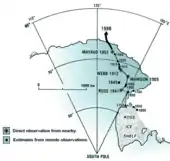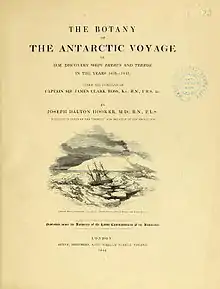Ross expedition
The Ross expedition was a voyage of scientific exploration of the Antarctic in 1839 to 1843, led by James Clark Ross, with two unusually strong warships, HMS Erebus and HMS Terror. It explored what is now called the Ross Sea and discovered the Ross Ice Shelf. On the expedition, Ross discovered the Transantarctic Mountains and the volcanoes Erebus and Terror, named after his ships. The young botanist Joseph Dalton Hooker made his name on the expedition.

The expedition inferred the position of the South Magnetic Pole, and made substantial observations of the zoology and botany of the region, resulting in a monograph on the zoology, and a series of four detailed monographs by Hooker on the botany, collectively called Flora Antarctica and published in parts between 1843 and 1859. The expedition was the last major voyage of exploration made wholly under sail.
Among the expedition's biological discoveries was the Ross seal, a species confined to the pack ice of Antarctica.
Expedition

People
The expedition was led by a Captain of the Royal Navy, James Clark Ross, who commanded HMS Erebus. HMS Terror was commanded by Ross's close friend, Francis Crozier.[1]
The botanist Joseph Dalton Hooker, then aged 23 and the youngest person on the expedition, was assistant-surgeon to Robert McCormick, and responsible for collecting zoological and geological specimens.[2][3] Thomas Abernethy, who had been on previous Arctic expeditions with Ross, was gunner. Hooker later became one of England's greatest botanists; he was a close friend of Charles Darwin, and became director of the Royal Botanical Gardens, Kew for twenty years.[4][5] McCormick had been ship's surgeon for the second voyage of HMS Beagle under Captain Robert FitzRoy, along with Darwin as gentleman naturalist.[6]
Ships
The expedition was made in two unusually strong[7] warships, HMS Erebus and HMS Terror. Both were bomb ships, named and equipped to fire heavy mortar bombs at a high angle over defences, and were accordingly heavily built to withstand the substantial recoil of these three-ton weapons.[7] Their solid construction ideally suited them for use in dangerous sea ice that might crush other ships. The 372-ton Erebus had been armed with two mortars – one 13 in (330 mm) and one 10 in (250 mm) – and 10 guns.[8]
Voyage

In September 1839, the Erebus and the Terror departed Chatham, arriving at Tasmania (then known as Van Diemen's Land) in August 1840. On 21 November 1840 they departed for Antarctica. In January 1841, the ships landed on Victoria Land, and they proceeded to name areas of the landscape after British politicians, scientists, and acquaintances. Mount Erebus, on Ross Island, was named after one ship and Mount Terror after the other.[9] McMurdo Bay (now known as McMurdo Sound) was named after Archibald McMurdo, senior lieutenant of the Terror.[10]
Reaching latitude 76° south on 28 January 1841, they spied
...a low white line extending from its eastern extreme point as far as the eye could discern... It presented an extraordinary appearance, gradually increasing in height, as we got nearer to it, and proving at length to be a perpendicular cliff of ice, between one hundred and fifty and two hundred feet above the level of the sea, perfectly flat and level at the top, and without any fissures or promontories on its even seaward face.[11]
Ross called this the Great Icy Barrier, now known as the Ross Ice Shelf, which they were unable to penetrate, although they followed it eastward until the lateness of the season compelled them to return to Tasmania. The following summer, 1841–42, Ross continued to survey the "Great Ice Barrier", as it was called, continuing to follow it eastward. Both ships stayed at Port Louis, in the Falkland Islands for the winter, leaving in September 1842 to explore the Antarctic Peninsula, where they conducted studies in magnetism, and returned with oceanographic data and collections of botanical and ornithological specimens.[9]
The ships arrived back in England on 4 September 1843, having confirmed the existence of the southern continent and charted a large part of its coastline.[12] The Ross expedition was the last major voyage of exploration made wholly under sail.[13] Both the Erebus and the Terror would later be fitted with steam engines and used for the 1845–1848 Franklin expedition to the Northwest Passage, in which both ships (and all crew) would ultimately be lost.
Discoveries

Geography
Ross discovered the "enormous" Ross Ice Shelf, correctly observing that it was the source of the tabular icebergs seen in the Southern Ocean, and helping to found the science of glaciology.[15] He also identified the Transantarctic Mountains and the volcanoes Erebus and Terror, named after his ships.[16][17]
Magnetism
The main purpose of the Ross expedition was to find the position of the South Magnetic Pole, by making observations of the Earth's magnetism in the Southern hemisphere.[18] Ross did not reach the Pole, but did infer its position.[19] The expedition made the first "definitive" charts of magnetic declination, magnetic dip and magnetic intensity, in place of the less accurate charts made by the earlier expeditions of Charles Wilkes and Dumont d'Urville.[15]
Zoology

The expedition's zoological discoveries included a collection of birds. They were described and illustrated by George Robert Gray and Richard Bowdler Sharpe in The Zoology of the Voyage of HMS Erebus & HMS Terror.[2][20][21]
The expedition was the first to describe the Ross seal, which it found in the pack ice, to which the species is confined.[15]
Botany



The expedition's botanical discoveries were documented in Joseph Dalton Hooker's four-part Flora Antarctica (1843–1859). It totalled six volumes (parts III and IV each being in two volumes), covered about 3000 species, and contained 530 plates figuring in all 1095 of the species described. It was throughout "splendidly"[22] illustrated by Walter Hood Fitch.[22] The parts were:
- Part I Flora of Lord Auckland and Campbell's Islands (1843–45)
- Part II Flora of Fuegia, the Falklands, Kerguellen's land, etc (1845–47)
- Part III Flora of New Zealand (1851–53) (2 vols)
- Part IV Flora of Tasmania (1853–59) (2 vols)
Hooker gave Charles Darwin a copy of the first part of the Flora; Darwin thanked him, and agreed in November 1845 that the geographical distribution of organisms would be "the key which will unlock the mystery of species".[23]
Influence
In 1912, the Norwegian explorer Roald Amundsen wrote of the Ross expedition that "Few people of the present day are capable of rightly appreciating this heroic deed, this brilliant proof of human courage and energy. With two ponderous craft – regular "tubs" according to our ideas – these men sailed right into the heart of the pack [ice], which all previous explorers had regarded as certain death ... These men were heroes – heroes in the highest sense of the word."[24]
Hooker's Flora Antarctica remains important; in 2013 W. H. Walton in his Antarctica: Global Science from a Frozen Continent describes it as "a major reference to this day", encompassing as it does "all the plants he found both in the Antarctic and on the sub-Antarctic islands", surviving better than Ross's deep-sea soundings which were made with "inadequate equipment".[15]
References
- Paine, Lincoln P. (2000). Ships of Discovery and Exploration. Houghton Mifflin. pp. 139–140. ISBN 0-395-98415-7.
- Chisholm, Hugh, ed. (1911). . Encyclopædia Britannica (11th ed.). Cambridge University Press.
- Desmond, R. 1999. Sir Joseph Dalton Hooker: Traveller and Plant Collector. Antique Collectors' Club and The Royal Botanic Gardens, Kew. ISBN 1-85149-305-0. Page 18
- Huxley, Leonard 1918. Life and letters of Sir Joseph Dalton Hooker OM GCSI. London, Murray.
- Turrill W.B. 1963. Joseph Dalton Hooker: botanist, explorer and administrator. Nelson, London.
- Browne, E. Janet (1995). Charles Darwin: vol. 1 Voyaging. Jonathan Cape. p. 205. ISBN 1-84413-314-1.
- Godbey, Holly (23 June 2017). "Recent Discovery of Wrecked HMS Terror, a Bombing Vessel From a Failed Arctic Expedition". War History Online.
- Janet Davison (27 September 2015). "Franklin expedition: New photos of HMS Erebus artifacts, but still no sign of HMS Terror". CBC News. Archived from the original on 2015-11-26. Retrieved 2015-12-19.
- Ross, James Ross (1847). A Voyage of Discovery and Research in the Southern and Antarctic Regions, During the Years 1839–43. 2. London: John Murray.
- James Clark Ross, A Voyage of Discovery and Research in the Southern and Antarctic Regions During the Years 1839–1843, Vol I, J. Murray, 1847, p.245
- Ross Volume I p.218
- Desmond, Ray (2006). Sir Joseph Dalton Hooker: Traveller and Plant Collector. Antique Collectors Club. p. 85.
- Ward, P. 2001. Antarctic expedition, 1839–1843, James Clark Ross
- NOAA National Geophysical Data Center. "Wandering of the Geomagnetic Poles". Retrieved 8 March 2017.
- D. W. H. Walton (28 March 2013). Antarctica: Global Science from a Frozen Continent. Cambridge University Press. p. 7. ISBN 978-1-107-00392-7.
- "James Clark Ross (1800–1862)". Glasgow Digital Library. Retrieved 26 February 2016.
- Coleman, E. C. (2006). The Royal Navy in Polar Exploration, from Frobisher to Ross. Tempus. pp. 329–335. ISBN 0-7524-3660-0.
- "New Scientist". 7 October 1982: 53. ISSN 0262-4079. Cite journal requires
|journal=(help) - Polar Research Board; Division on Engineering and Physical Sciences; National Research Council (1 January 1986). Antarctic Treaty System:: An Assessment: Proceedings of a Workshop Held at Beardmore South Field Camp, Antarctica, January 7–13, 1985. National Academies Press. p. 90. ISBN 978-0-309-03640-5.
- Gray, John Edward. The Zoology of the Voyage of H.M.S. Erebus & Terror Under the Command of Captain Sir James Clark Ross, R.N., F.R.S., During the Years 1839 to 1843, E. W. Janson, 1875.
- Richardson, John; Gray, John Edward, eds. (1844–1875). The Zoology of the Voyage of H.M.S. Erebus & Terror Under the Command of Captain Sir James Clark Ross, R.N., F.R.S., During the Years 1839 to 1843 Vol. 1: Mammalia, Birds. E. W. Janson.
- Curtis, Winifred M. (1972). Hooker, Sir Joseph Dalton (1817–1911). Australian Dictionary of Biography (Volume 4). MUP.
- Darwin, Charles. "Letter from Darwin, C. R. to Hooker, J. D. on [5 or 12 Nov 1845] (MS DAR 114: 45, 45b)". University of Cambridge. Retrieved 25 February 2016.
- "Erebus and Terror – The Antarctic Expedition 1839–1843, James Clark Ross". Cool Antarctica. Retrieved 26 February 2016.